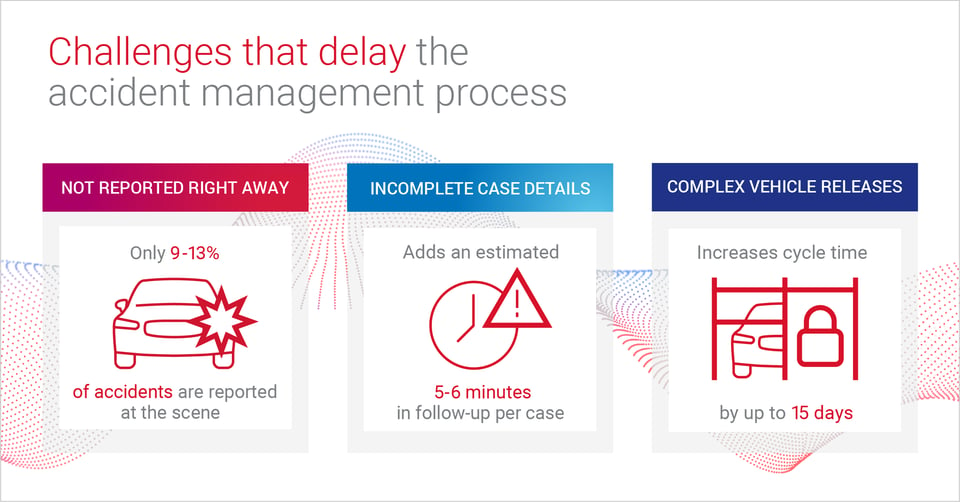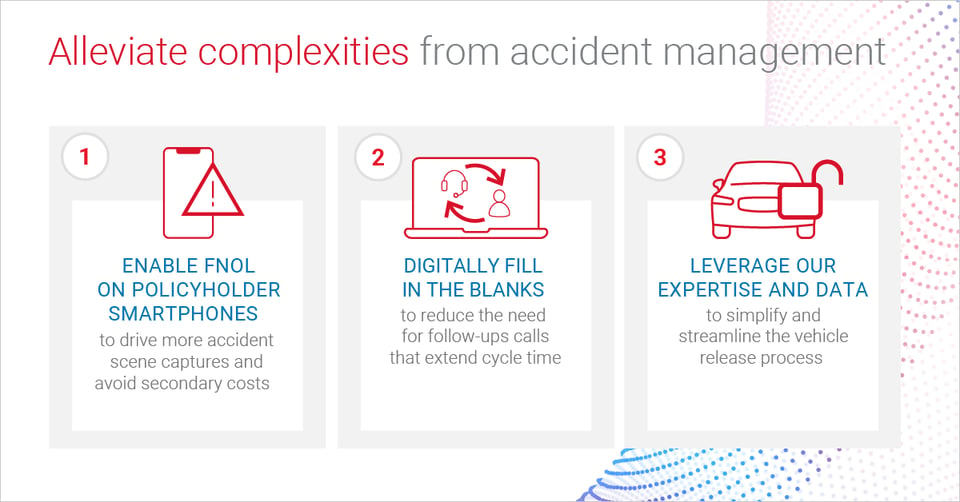Minimizing loss costs and expenses, cycle time, and driving a positive policyholder experience are key objectives to making any accident management program successful. In today’s landscape with higher accident severity and rising cost to rent or repair, this objective becomes even more imperative with loss costs trending upwards. Furthermore, continued supply/demand challenges across the industry could mean that this ongoing problem is expected to continue for some time. This new challenge along with existing complexities of accident management add an increased emphasis on the need for insurers to explore every possible option to reduce cost and cycle time.

Challenges of Accident Management
Drivers rarely report the accident from the scene
When a driver is involved in an accident, they are understandably stressed and overwhelmed. Between concerns over the well-being of themselves, their passengers, and damages to their vehicle, it’s not surprising that submitting first notice of loss is seldom top of mind. In fact, only an estimated 9-13% of accidents are reported from the accident scene, which means the majority of accidents incur avoidable secondary costs that result from a delayed vehicle recovery. From storage and rental fees to secondary tows, the total secondary costs can add up to $700 - 925 per claim.
Incomplete or delayed information adds time, effort, and cost to the cycle
Even in cases where a customer reports the accident directly from the scene, incomplete information can require additional follow-up calls that delay vehicle pickup and overall cycle time. With added delays also comes the risk of keeping the vehicle in storage, accumulating storage and rental fees as the missing information is collected.
Varying vehicle release requirements adds complexity
When a vehicle is not recovered from the accident scene, a new challenge arises: dealing with vehicle release. The vehicle release process can be rather complex due to varying requirements from state to state and even shop to shop. Whether its negotiating release fees, cash requirements, or processes and paperwork, securing a vehicle release from a storage yard or salvage lot requires a certain level of expertise to effectively navigate. Without this experience, release costs can also add up and cycle time can be extended by an industry average 5-15 days.
What solutions can insurers employ?
Recover more vehicles from the accident scene with Crash Detection Response
One of the best tools at an insurer’s disposal is their customers’ smartphone. With 90% of the population already owning a smartphone, the technology is likely already in the vehicle at the time of the accident. By utilizing the smartphone’s existing sensors, a driver’s mobile device can detect a sudden change in speed or impact and can accurately identify this sudden change as a crash through mobile telematics. Once detected, their phone can begin compiling essential crash details such as velocity, location, and even whether a customer was using their phone while driving. These details are then instantly shared with the insurer to begin a claim. This approach also enables a notification to be sent to emergency services so they can dispatch police and EMS to the scene to provide support.
Eliminate the need for a phone call with mobile app integration
Connecting an insurer's claims system to a mobile app provides the option to submit details of the accident digitally, removing the barrier of a phone call and in turn reducing congestion from the contact center. Not only does this simplify the customer experience, it also utilizes contact center resources more efficiently. Location data and details can also be automatically detected, automating the collection and sharing of essential case information.
Enable digital follow-up with Accident Management Dashboard
Accident Management Dashboard makes it easy to handle and update cases through an easy-to-use interface. It also helps to expedite follow-up communications when additional action or information is required through a digital Two-Way Communication feature – all while eliminating the need for an outbound phone call. Instead, claims handlers can digitally update final tow destination, approve advanced charges, share updates, and request receipts. Because this is all done digitally, the requested information can be shared much quicker to ensure there are no hiccups that delay cycle time.
Leverage experience to alleviate vehicle release complexity
Experience in accident management significantly simplifies the complexities of releasing a vehicle from storage. Having navigated this landscape for nearly two decades, our experience helps us to anticipate requirements and negotiate the best release fees. Not to mention, our team of dedicated release coordinators manage the entire release process, so agents can focus on your customers. Even in cases when on scene capture was not possible, insurers can still benefit from simplicity, cost reduction, and a shorter process for your policyholders.

End-to-end cost reduction and simplicity
There are many challenges and complexities with managing the accident lifecycle efficiently. Embracing a digital approach and leveraging an experienced partner reduces these roadblocks to deliver exponential benefits for your customers and claims organization. At Agero, we’re constantly looking to drive your program forward with our experienced people and innovative technology – whether that’s enabling more accident scene tows to maximize your cost avoidance or simplifying vehicle release, we’re here to make sure the accident management process is smooth and efficient every step of the way!




 Mubbin is Agero’s product and technology lead for the Accident Management business, responsible for delivering innovative solutions that address critical financial levers in the auto claims value chain. He comes from a P&C background, and is passionate about the intersection of process, technology and organizational enablement of the claims experience.
Mubbin is Agero’s product and technology lead for the Accident Management business, responsible for delivering innovative solutions that address critical financial levers in the auto claims value chain. He comes from a P&C background, and is passionate about the intersection of process, technology and organizational enablement of the claims experience.